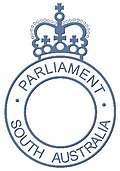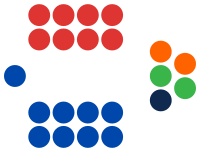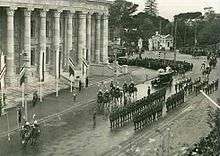Parliament of South Australia
The Parliament of South Australia at Parliament House, Adelaide is the bicameral legislature of the Australian state of South Australia. It consists of the 47-seat House of Assembly (lower house) and the 22-seat Legislative Council (upper house). All of the lower house and half of the upper house is filled at each election. It follows a Westminster system of parliamentary government.
Parliament of South Australia | |
|---|---|
| 53rd Parliament | |
 | |
 | |
| Type | |
| Type | Bicameral |
| Houses | House of Assembly Legislative Council |
| Leadership | |
Queen of Australia | Elizabeth II since 6 February 1952 |
Hieu Van Le since 1 September 2014 | |
| Structure | |
| Seats | 69 47 MHA 22 MLC |
.svg.png) | |
House of Assembly political groups | Government Liberal (24) Opposition Labor (19) Crossbench Independent (4)[lower-alpha 1] |
 | |
Legislative Council political groups | Government Liberal (9) Opposition Labor (8) Crossbench SA-BEST (2) Greens (2) Advance SA (1) |
| Elections | |
| Instant-runoff Vote | |
| Single Transferable Vote | |
Last general election | 17 March 2018 |
Next general election | 19 March 2022 |
| Meeting place | |
| Parliament House, Adelaide, South Australia, Australia | |
| Website | |
| www.parliament.sa.gov.au | |
The Queen is represented in the State by the Governor of South Australia. According to the South Australian Constitution, unlike the Federal Parliament, and the parliaments of the other states of Australia, neither the Sovereign or the Governor is considered to be a part of the South Australian Parliament. However, the same role and powers are granted to them.[1]
History
Parliament House |
Recreated lower and upper house booths, history, and voting procedures |
 SA Parliament Opening |
The Legislative Council was the first Parliament in South Australia, formed as a result of the South Australia Act 1842, and replaced the South Australian Colonisation Commission appointed in 1834 by means of the South Australia Act 1834. The 1842 Act gave the British Government, which was responsible for appointing a Governor and at least seven other officers to the Council, full control of South Australia as a Crown Colony, after financial mismanagement by the first administration had nearly bankrupted the colony.[2] The Act also made provision for a commission to initiate the establishment of democratic government, electoral districts, requirements for voting rights, and terms of office.[3]
Women gained the right to vote and stand for election in 1895, taking effect at the 1896 election.[4][5]
South Australia became a state of the Commonwealth of Australia in 1901, following a vote to federate with the other British colonies of Australia.
Elections were held every 3 years until 1985, when the parliament switched to 4 year terms, meaning 8 year terms for the upper house. Beginning in 2006, election dates have been fixed at the third Saturday in March of every fourth year.[6]
House of Assembly
The House of Assembly (or "lower house") is made up of 47 members who are each elected by the full-preference instant-runoff voting system in single-member electorates. Each of the 47 electoral districts (electorates) contains approximately the same number of voters.
Since 1975, the distribution of electoral boundaries has been set by the South Australian Electoral Districts Boundaries Commission.[6] Since 1991, boundaries have been redistributed after each election by the Electoral Commission of South Australia, an independent body. Previously they were redistributed after every third election.
Government is formed in the House of Assembly by the leader of the party or coalition who can demonstrate they have the support of the majority of the House, and is called upon by the Governor to form government. The leader of the government becomes the Premier.
While South Australia's total population is 1.7 million, Adelaide's population is 1.3 million − uniquely, over 75 percent of the state's population resides in the metropolitan area and has 72 percent of seats (34 of 47) alongside a lack of comparatively-sized rural population centres, therefore the metropolitan area tends to decide election outcomes. At the 2014 election for example, although the statewide two-party vote (2PP) was 47.0% Labor v 53.0% Liberal, the metropolitan area recorded a 2PP of 51.5% Labor v 48.5% Liberal.[7]
Legislative Council
The Legislative Council (or "upper house") is made up of 22 councillors (MLCs) who are elected for the entire state by the Proportional Representation single transferable voting system (with optional preferential voting) to serve for a term of 8 years. Elections for the Legislative Council are staggered so that 11 seats are up for re-election every 4 years, at the same time as House of Assembly elections.
The primary function of the Legislative Council is to review legislation which has been passed by the House of Assembly. This can cause tensions between the government and the Legislative Council, which may be viewed by the former as obstructionist if it rejects key legislation, as can happen at times when the electoral makeup of the two houses are different.
Location
The seat of the Parliament of South Australia is Parliament House in the state capital of Adelaide. Parliament House sits on the North-Western corner of the intersection of King William Street and North Terrace.[8]
See also
- Constitution of South Australia
- List of elections in South Australia
- Official openings by the monarch in Australia
- Parliaments of the Australian states and territories
- Premier of South Australia
Notes
- Current independent MPs: Frances Bedford (Florey), Troy Bell (Mount Gambier), Geoff Brock (Frome) and Sam Duluk (Waite)
References
- "Constitution Act 1934". South Australia: Parliament of the United Kingdom. 1934. Retrieved 9 October 2011.
- "South Australian Colonization Commission". Bound for South Australia. Creative Commons 3.0. History Trust of South Australia. Retrieved 5 November 2019.CS1 maint: others (link)
- "An Act to provide for the better Government of South Australia [30th July 1842]: Anno 5o et 6o Victoriae" (PDF). Founding Documents. Retrieved 13 November 2019.
- "Women's Suffrage Petition 1894: parliament.sa.gov.au" (PDF). Archived from the original (PDF) on 29 March 2011. Retrieved 8 January 2016.
- "Women and Politics in South Australia". Parliament of South Australia. 19 February 2009. Archived from the original on 16 April 2019. Retrieved 17 April 2015.
- History of Redistributions, South Australian Electoral Districts Boundaries Commission
- Metropolitan 2PP correctly calculated by adding raw metro 2PP vote numbers from the 34 metro seats, both Labor and Liberal, then dividing Labor's raw metro 2PP vote from the total, which revealed a Labor metropolitan 2PP of 51.54%. Obtained raw metro 2PP vote numbers from ECSA 2014 election statistics Archived 7 March 2016 at the Wayback Machine, ECSA 2014 Heysen election Archived 11 December 2014 at the Wayback Machine and ABC 2014 Fisher by-election.
- "Google Maps". Google Maps. Retrieved 3 October 2017.
Further reading
- Dunstan, Don (1976). "John Curtin Memorial Lecture: Electoral reform in South Australia" (PDF).
- Stretton, Pat (1988). The Life and Times of Old Parliament House. Old Parliament House, North Terrace, Adelaide. ISBN 0-7243-7982-7.
External links
| Wikimedia Commons has media related to Parliament of South Australia. |